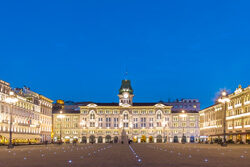
The Triestini embrace life with a passion that is palpable and infectious, if the chatter at evening aperitivo is anything to go by. And at the merest hint of sunshine, Triestini are off to the nearby seaside, Barcola, even in November, and even though it’s a concrete strip.
A plaque commemorates the spot where Mussolini announced his policy of racial laws against the Jews. The Catholic Church of Saint Antonio shares space on the Grand Canal with the Serbian Orthodox Church; the synagogue is two minutes away.
Piazza dell’Unità d’Italia is a large and elegant outdoors space opposite the waterfront, with some impressive buildings, a curious fountain and several cafes. Over the road, the old docks are fairly quiet, offering interesting strolls beside the sea and out along a wide quay. It’s worth a glance at some of the old maritime buildings, whose once-impressive architecture is unloved and decaying.
Heading uphill from the waterfront you’ll reach the town’s fortress, the Castello di San Giusto. Just below the castle walls is the ancient Cattedrale di San Giusto. The cathedral houses the remains of the San Giusto (St. Justus or Just), and is a lovely building, dating back to the amalgamation of two different churches in the fourteenth century. The site is much older, as a Roman temple is believed to have stood here.
Taking the road downhill opposite the cathedral, you’ll come to a picturesque Roman arch in a small square, and to the grand Baroque Basilica di Santa Maria Maggiore. Alongside this imposing church is a much smaller and older one, San Silvestro. Taking the flight of steps down from these two churches and turning right will bring you to Trieste’s Roman theatre. This dates to the 1st century AD and is sufficiently well-preserved to give a sense of how it would have looked. The theatre can be admired from the street, and is echoed on the other side by the curving modern architecture of the Questura.